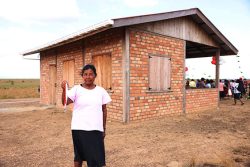Dear Editor,
Were there to be a pound of sugar for each word written about this now infamous Skeldon Sugar Modernisation Project (SSMP), its production objectives might well have been met. A flippant viewpoint, for sure. But recently, there’s been renewed interest, with numerous Letter to the Editor, and equally numerous comments on these letters. And presently, with the cluster of the Project buildings only partly active (the Power Plant), and the surrounding large acreages of overgrowing sugarcane, many more letters are likely to be written.
I am reluctant to add to this volume of words, however, I suspect that the issues I now comment on, may not have been raised before.
In the early 1990’s, GuySuCo, under its Booker Tate management had begun to show positive gains; there was, coincidentally the arrival of the new PPP administration. It was inevitable that lofty ideas would emanate from the Cheddi Jagan Government, conceptualising Expansion and Modernisation for the hitherto much-battered Sugar Industry. Booker Tate, from its perspective would consider any role in this as being quite compatible with their own corporate Objectives.
The CEO conducted some excellent Head Office briefings, with comprehensive comparison of the performances of the eight (8) Estates, revealing vividly the superior performance of Skeldon over all others, with a unanimous consensus that this was where the action should be. A new Plant, almost thrice the existing one, incorporating the newer Technologies, Electricity Cogeneration, extensive Instrumentation/Automation, aimed at reducing Production Cost, to enable competition on the World Market was being recommended. The CEO took pains to stress the importance of the match between factory capacity and available cane; specifically, the part that farmers cane would need to play, and the need for Government support for this sector.
The South African Factory Felixton 2 was mooted as a model; it is appropriate, however to note here that Felixton 2 was a private venture, that South Africa boasted world-class Engineering and Manufacturing expertise, as well as a world-famous Sugar Research Institute.
Booker Tate would certainly be cognisant of the local shortcomings, and if it did not actually initiate them, would have fully supported GuySuCo, by the mid 1990, to take two (2) noteworthy steps:
Firstly, a Projects Department was established in the Head Office, to enable the Factory Operations Department to focus on routine issues. This Department would undertake new Capital Projects, and would in due course, take charge of the SSMP. The Projects Director heading the Team was an experienced Guyanese with considerable local and overseas experience, and he was joined by a Projects Engineer with similar background. The Team would later include other Guyanese experts; an experienced Sugar Technologist was to join the Team after his imminent retirement, and a Mechanical Engineer and a Sugarcane Agriculturist were seconded from Booker Tate.
Secondly, the Government proposed the creation, at the University of Guyana (UG), of the Cheddi Jagan Chair in Sugar Technology. The specific objectives were understandably open-ended at that time, but by involving the country’s foremost Educational establishment in this way, would hopefully include a recapture of the reputation of the Imperial College of Tropical Agriculture (ICTA) some 30 years earlier, as well as meeting some of the potential needs surfacing arising from the planned Industry Modernisation. Two (2) GuySuCo Staff members were selected to collaborate with the Deans of the Faculties of Technology and Chemistry at UG and develop a Programme of Study. The initial search for a Professor of Sugar Technology proved fruitless, and the ideas for a Chair were scaled down somewhat, eventually to that of a sandwich type Certificate Course, possibly to attract new entrants to the Sugar Industry, as well as upgrading existing unqualified staff, who had progressed from within the ranks. Lecturers would comprise University staff, and Booker Tate/GuySuCo for the specialisms. The Factories were reasonably adequate for the practicals, and supplementary to the roles of UG’s own Workshops and Laboratories.
But by the late 1990s, both these promising developments had unfortunately collapsed.
For no immediately evident reason, the Projects Department was disbanded; the Director sought his fortune elsewhere, and Booker Tate was put in sole charge of the SSMP. Also, the demands which were being made by UG Staff in respect of allowances: sabbaticals for lecturers to overseas Sugar Industries, and Expenditure requests for non-sugar apparatus and equipment deemed exorbitant, probably convinced the Guyana Government to scrap the idea without further discussion, in some effort to reach any workable arrangement.
There are relevant “What if” questions in respect of the impact the above collapses might have had on SSMP. It had been surmised that, as UG seemed to have then exhibited a pro-PNC stance, cooperation with a pro-PPP GuySuCo was not possible. Was there some rationale concerning the makeup of Guyanese Project Team, that led to its replacement by Booker Tate?
Important as the new Plant was, in respect of Design Specifications, Procurement, Installation and Construction, the Project Team had, before its disbandment begun to also apply its collective experience on other issues, which could easily be shirked or down-played. These would include:
Identification and training of the managers, supervisors, operators and maintenance personnel for the new Plant.
Extensive test-run of the new equipment, ranging from the simplest START/STOP, “dry runs”, to “wet runs”, ultimately to short actual periods passing cane, then extended runs, with close expert observation and monitoring. Factories have traditionally practised so-called Steam trials prior to every crop, and the SSMP was considerably more complex. An open discussion even centred on whether to operate both the old and the new factories simultaneously, for the commissioning period. This would require a high level of innovation. For example, if the cadre of operators etc. was to be selected for training from the existing Factory manpower, the old Plant may have to be kept functioning on a 2-shift basis. But of course, this brainstorming was to no avail.
An important question will have to be to what extent were the pre-commissioning regimes actually carried out for the SSMP. And whether this was a factor in the SSMP’s failure.
It may be a mere coincidence that the two (2) reversals which have been described above happened around the time that Dr. Jagan passed away. It is a not unreasonable conjecture that the former President did indeed regard SSMP not as a mere prestige feature to add gloss to his beloved sugar belt, but as an opportunity which could have contributed in some deeper way, to raising a national awareness.
Sincerely
J M Ragnauth







